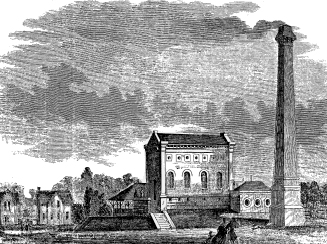![[Industrial Trail Logo]](logosmall.jpg) MADE
IN HAMILTON
MADE
IN HAMILTON20TH CENTURY
INDUSTRIAL TRAIL
![[Industrial Trail Logo]](logosmall.jpg) MADE
IN HAMILTON
MADE
IN HAMILTON
20TH CENTURY
INDUSTRIAL TRAIL
SITE
17
HAMILTON
WATERWORKS, 1859
HAMILTON MUSEUM OF STEAM AND TECHNOLOGY
 The
Hamilton Museum of Steam and Technology is located in Hamilton's first public
water-works, completed in 1859 and now a National Historic Site. The site is
the only mid-19th century waterworks surviving intact in North America. All
the major buildings are preserved, including the boilerhouse, pumphouse, chimney
and fuel shed. Other features such as the worker's houses and the elaborate
landscaping are only visible as fragments.
The
Hamilton Museum of Steam and Technology is located in Hamilton's first public
water-works, completed in 1859 and now a National Historic Site. The site is
the only mid-19th century waterworks surviving intact in North America. All
the major buildings are preserved, including the boilerhouse, pumphouse, chimney
and fuel shed. Other features such as the worker's houses and the elaborate
landscaping are only visible as fragments.
Thomas Coltrin Keefer, a prominent civil engineer, designed the system. The plan included two steam-powered pumping engines that drew water from nearby Lake Ontario and pushed it to a reservoir two miles west and 190 feet above the level of the lake. From the reservoir, water flowed downhill into the city.
 The
waterworks provided clean water for citi-zens but also much needed water for
factory processes. The system included fire hydrants which limited fire damage
and lowered insurance rates - an important factor in garnering support for the
project from the business community. The steam engines were constructed in Dundas,
Ontario by the John Gartshore Co. Built to a very advanced design, the engines
and pumps operated continuously until 1910.
The
waterworks provided clean water for citi-zens but also much needed water for
factory processes. The system included fire hydrants which limited fire damage
and lowered insurance rates - an important factor in garnering support for the
project from the business community. The steam engines were constructed in Dundas,
Ontario by the John Gartshore Co. Built to a very advanced design, the engines
and pumps operated continuously until 1910.
The municipal pumping station projected a strong and prosperous image for the city. The waterworks illustrates the Italianate architectural style favoured for industrial and public works structures in the 1850s. Notice the elaborate brickwork on the chimney, the Romanesque windows and the irregular stonework.
By 1887, the waterworks could no longer meet the ever-increasing demand for water. In that year, a second pumping station was built beside the original building. This station contained two engines, designed and built in Hamilton by the Osborne-Killey Co. This company was later re-named Smart-Turner and the factory site is included on this trail.
In 1910, a new station with electric and steam turbine driven pumps replaced the older installations. The steam engines remained as backup engines. By 1938, the need for backup engines had passed and engineers laid up the two older plants.
In addition to preserving this important landmark, the Hamilton Museum of Steam and Technology conserves and interprets the region's industrial heritage.
James McFarlane, joined the waterworks as the Chief Engineer in 1859. He retired in 1910 at the age of 81.
The original area was a mixture of farmland, marsh and woods. Since 1859, the district has become a mixed light industrial and residential neighbourhood.
Keefer may have sought architectural help from Thomas Seaton Scott, a Montreal architect. A water-colour of a building resembling the Hamilton station is preserved in the Scott collection at the National Archives of Canada.
Workers at the museum are organized as CUPE 5167.